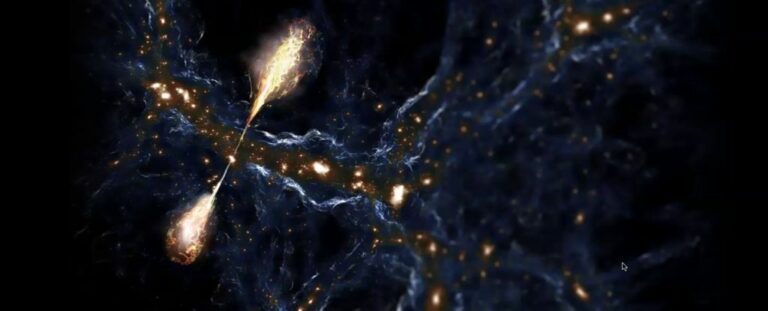Record-Breaking Black Hole Jets Form Mind-Blowing Galactic Structure
They have also observed the largest known galactic structure which was produced by a supermassive black hole which shoots asterophysical jets.
Known as Porphyrion after the king of the giants in Greek mythology this structure measures an amazing 7 megaparsecs or 23 million light years across and plays a major role in the architecture of the Universe.
Porphyrion shows how the big and the small cosmic structures are interrelated As you have a black hole that ‘gives birth’ to a structure on the scale of cosmic filaments and voids, Martijn Oei, an astronomer from Leiden University and Caltech said to ScienceAlert.
‘If we made the jets the size of Earth, the black hole itself would be but 0. 2 millimeters wide – the width of an amoeba or a mite that you can barely see on your skin,’ ‘So these are jets, of an organism the size of an amoeba or a mite on your skin creating a stream of energy the size of Earth.
This brings about many questions, more so because it is not the only incident to have been reported. In particular, it comes after the revelation of Alcyoneus – a galaxy with jets measuring 16 million light-years long. That such large black hole jets are possible implies that the circumstances to create such large scale structures can be more prevalent in the Universe than expected.
Transitional black hole jets are familiar but how they are formed remains a mystery. When a black hole devours material there exists a mechanism which diverts and accelerates some of it along magnetic fields, then spews it out as plasma jets at almost the speed of light. Such jets are typical for the Universe, but the monumental sizes of the jets of Alcyoneus and Porphyrion create real problems.
For making such gigantic jets, the black hole requires fuel for a substantially long time or for about a billion years. Furthermore, the existence of jets in the flows that occur in Porphyrion jets’ formation time at early stages in the Universe, over time should give way to instability and disintegration at denser environments.
‘Of course Jets are un-stable structures,’ Oei averred. >When disturbances emerge, the jets are amplified rather than decreased and result into the jets being annihilated whereas the sustained supply, taking billions of years, may be the limiting factor of the jets but the limit is still unknown.
Nevertheless, while the Jovian aerosol called Porphyrion was not the biggest cloud, its jets were steady over an enormous distance, which might hold the key to the Universe’s formation. Cosmic web connects galaxies and is composed of extensive structures of dark mater, which create voids between galaxies. Estimations show that Porphyrion’s jets reached, on average, 66% of radius of the space it occupied, which means these jets could participate in formation of the cosmic web.
Scientists speculating that these jets could be the cause of high temperatures and magnetic fields in voids pointing to the fact that they may have played a massive role in formation of the Universe that is unknown to most. The kind of black hole in Porphyrion itself is no stranger; it is the radiative-mode active black hole, a characteristics that are predominant in early universe. This hint indicates that such huge jets may have been more frequent than estimated earlier and participated in the formation of the cosmic web during the early stages of the Universe.
Oei believed that much more galaxy with giant jets are yet to be revealed to the public. Little said only that he believes that there may be more galaxies with giant jets than this statement currently indicates. “It means that the big jets become invisible and distance also matter, we probably will find many more galaxies with such massive jets through better observing equipment in the next few years. ”
And perhaps, some mysteries of the Universe as well to go along with the newly discovered celestial neighbours.
The team’s research has been published in Nature.
Do not forget to share your opinion with us to provide you with the best posts !




0 Comments